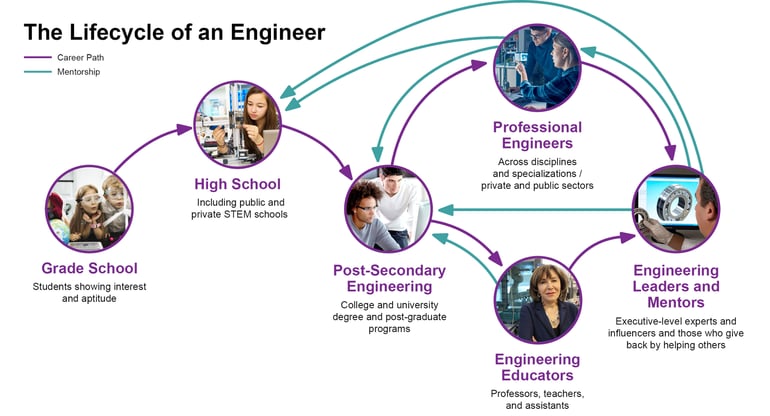 Most of us have worked at a tradeshow where a small group of excited students suddenly appear in front of us, asking a barrage of questions. There are usually two basic reactions. The first is to be delighted to have them there and actively engage. The other, which is far more common, is to barely show real interest while looking past them to see if a new prospect needs your attention.
Most of us have worked at a tradeshow where a small group of excited students suddenly appear in front of us, asking a barrage of questions. There are usually two basic reactions. The first is to be delighted to have them there and actively engage. The other, which is far more common, is to barely show real interest while looking past them to see if a new prospect needs your attention.
Offering a gift of time and wisdom is the right and polite thing to do. But often, due to our short-term business pressures, we want to move students along as quickly as possible - forgetting the fact that they are future potential customers and influencers in ways we can't imagine at that moment.
Perhaps a simple solution is to have designated "education ambassadors" or set up a dedicated education kiosk? At the very least, companies and marketers should avoid treating students as annoyances as we are making a crucial first impression on those who will build the future solutions to our biggest problems.
To keep things simple moving forward, I am using the term "engineering education" in a broader sense that includes all education levels and interrelated STEM (Science, Technology, Engineering, and Mathematics) fields and recognize that for most of us, it lasts a lifetime.
Engineering Academic and Career Ecosystem
When considering engineering education, the typical "Lifecycle of an Engineer" needs to be considered. The engineering profession is highly community-based, with many in the field eager to show and share their excellent work and ideas with others. The lifecycle is more of an ecosystem than a linear career progression since many engineers and leaders practice mentorship later in their careers.
 This diagram is by no means absolute since some become interested in the field later than others, and many become problem solvers, tinkerers, and inventors without formal education. Understanding this lifecycle should help companies think about the importance of connecting with these demographics at their different stages and how they interrelate over time.
This diagram is by no means absolute since some become interested in the field later than others, and many become problem solvers, tinkerers, and inventors without formal education. Understanding this lifecycle should help companies think about the importance of connecting with these demographics at their different stages and how they interrelate over time.
Why Engineering Education Matters
While most people recognize the value of education in any discipline - and I am admittedly biased - I believe that students in STEM programs are particularly critical for humanity to survive and thrive as we push further into this century. These students will become the men and women who will be designing, engineering, improving, and building our fast-changing world.
Today's students are tomorrow's inventors, innovators, and leaders. Educated and trained engineers solve many of humanity's problems, drive the global economy, and improve all aspects of our lives. Think about everything you own, use, and enjoy in your own life. Engineers were required to help develop those solutions safely. They design, define, and precisely document virtually everything around us.
There are several challenges today that make the focus and support of engineering education more critical than ever. A key priority is making sure we continue to have enough graduating students to supply the increasing demand for engineers needed in the workforce. As one might expect, a growing portion of this demand revolves around new technologies.
Some Other Considerations
When students have access to better teaching methods, more information, and new technologies or tools - they improve their creative and learning potential.
Creative engineering students at all levels, and particularly in postsecondary institutions, develop astonishing breakthroughs while still in school. Professors and teachers usually work closely with these students to refine their ideas and bring them to fruition. Universities are well-known hotbeds of innovation. A significant number of life-changing advancements are either developed in colleges and universities or began there. Some of these ideas lead to startup companies that become household names - Microsoft, Facebook, Dell, and Google, to name a few.
Professors and teachers also conduct academic and applied research. The discoveries they make become an integral part of their status, career advancement, and personal passion. Intellectual property developed by either individual educators or in conjunction with students or colleagues can also generate lucrative patent revenues for their schools.

Smart Companies Know It's Good Business!
There are many strong societal reasons why companies should do everything they can to support "engineering education." Some of the world's best companies also understand the importance from a business point of view - this is particularly true of technology companies. Most name-brand design software, hardware, networking, and other suppliers either donate their products for classroom use or deeply discount educational prices. These decisions may be partly altruistic, but leaders and marketers in these companies understand that the long-term play will reward their bottom lines in years to come.
Although there are many other ways to support engineering education, I have focused on companies assisting with technology. It's highly visible and can dramatically improve education quality by giving students access to the cutting-edge tools they will need once they hit the job market.
Public Relations Power
Helping to support engineering education builds substantial goodwill and marketing value from the schools themselves. It usually comes with free, wide-reaching publicity, and advocates within the schools are willing to share great stories about the partnerships they enjoy. There are many benefits to this type of exposure, and the buzz generated creates welcomed good news stories. Appreciating the help, educational leaders can become strong corporate allies and evangelists. Everybody wins!
The Recruiting Advantage
Another significant benefit of directly supporting education is the impact on human resources. When students finish their engineering programs with a high degree of proficiency using a specific CAD program, they are well-trained and ready to go. Both training and recruiting costs will be sharply reduced since hiring companies can target schools for students who already have the necessary skills. Students also tend to seek companies where they know their skills will be more valuable and easily applied - often through friends or relatives already working at these companies.
Brand Exposure
When a student uses a brand's technology for four years or longer, depending on the degree length, there is a constant reinforcement of that brand. Through familiarity, students develop a personal and emotional bond with the product and company that provides it. The attraction of preferred technologies is often difficult to change. Just think about ones you have used for years and decades without switching. These investments in education substantially reduce sales and marketing costs down the road.
The Development of the ProjectBoard Platform
A common theme through engineering education across grades involves project work. Project-based learning has become a mainstay at leading colleges and universities. Also, there is a growing movement of organizations worldwide that support aspiring engineering minds to share their passion for STEM solutions to everyday problems. Youth Science Canada is an excellent example of a partner we work with to help STEM students bring their passion, ideas, and projects to light.
For many years we knew that we needed a platform to inspire engineering-minded people to connect with their peers and work on innovative solutions to some of our most pressing problems. With this problem in mind, about 4 years ago, I decided to assemble a small team of the best in their fields to investigate this problem. Led by Renata Vaccaro and Lauren Baldesarra, the opportunity they came back with was a new platform called ProjectBoard, which we released for the public to use 2 years ago.
Earlier this year, engineering.com launched a joint venture with Make.co know as Make: Projects. By utilizing the ProjectBoard platform, Make: Projects enables education at all levels by helping students and educators to connect, create, collaborate, and document online in highly visual and immersive ways. It is already being embraced by leading universities such as Rice University and the University of Sheffield, and the site currently has more than 25,000 members and hosts over 8,000 projects.
Although several users pay to use Make: Projects privately and have customized it for their own specific needs, the platform is free for most everyone to use.

Other Student Outreach Initiatives at engineering.com
Along with ProjectBoard and Make: Projects, there are many other ways we support engineering education. Since our company began, we remain focused on nurturing students and enabling learning. Feedback and good relationships with educational organizations of all types have given us the unique ability to connect high school STEM students with technical universities, help students create their portfolios along the way, and support internships and industry placements right out of school.
Our website properties also provides a wealth of education-related resources. Some examples include:
- A Job Board on our site offers a powerful way for students to find their first engineering roles. It includes thousands of jobs across disciplines from emerging and leading companies.
- For students and professionals considering an Engineering Master's degree, our Master's Discovery Tool provides an excellent way to align their specific needs and goals with the schools and programs that will best match their decision-making criteria.
- The Education Editorial section of engineering.com serves continually updated information to help students at all levels. There is a wide range of topics, including academic insights and advice, trends driving future career choices, and relevant general interest articles.
- Our Games section on the site also gives students a place to unwind and engage in educational, spatial, and physics-based games that many schools use with their students.
- Our leading Global engineering forum Eng-Tips recently created a new category specifically for students to find information and share ideas with other students and engineers.
Final Thoughts
For many companies already working to help improve that state of engineering education, I want to extend my congratulations and say well done! For those who have education low on the priority list, I trust my viewpoint will get you thinking about it differently and hopefully considering it as part of your outreach strategies.
As you have likely gathered by now, I'm rather passionate about this subject. Having been an engineering student back in the day, I have always been and continue to appreciate the ever-evolving engineering education. To that end, I do my best to help support and advance it - both personally and through our engineering.com efforts. It is my fundamental belief that STEM education interests are best served when learning institutions work closely with private industry.
Thank you for reading, and I hope you are coping well during these challenging times. I am always available to discuss ways for you to get involved with our mission, so please don’t hesitate to reach out to me or someone on our team.






